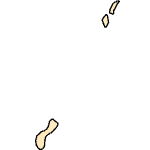Erpeton tentaculatum
(Tentacled Snake)
Reptiles-Snakes
Exotic |
|
Common name: Tentacled Snake
Taxonomy: available through
www.itis.gov
Native Range: This species is endemic to Peninsular Southeast Asia, occurring in Thailand and southern Vietnam (Uetz, 2012).



|

Alaska |

Hawaii |

Puerto Rico &
Virgin Islands |

Guam Saipan |
Hydrologic Unit Codes (HUCs) Explained
Interactive maps: Point Distribution Maps
Nonindigenous Occurrences:
Table 1. States with nonindigenous occurrences, the earliest and latest observations in each state, and the tally and names of HUCs with observations†. Names and dates are hyperlinked to their relevant specimen records. The list of references for all nonindigenous occurrences of Erpeton tentaculatum are found here.
Table last updated 12/19/2025
† Populations may not be currently present.
Ecology: This species inhabits stagnant or slow moving bodies of water with emergent-submergent vegetation (Uetz, 2012). During the dry season it will bury itself under the mud until the rainy season returns. It can be found in fresh, brackish, and sea water (Murphy et al. 2010). This rear-fanged aquatic snake feeds exclusively on fish, which is accomplished via an ambush method. It lives its entire life in murky water and can stay underwater for up to 30 minutes without coming up for air. It can move only awkwardly on land. In dry times and at night, the snake may burrow itself in the mud. The 5-13 young develop ovoviviparously (eggs hatch internally) and are born live underwater (Thiesen, 2012).
Means of Introduction: Pet release.
Status: A breeding population is not suspected.
Impact of Introduction: The impacts of this species are currently unknown, as no studies have been done to determine how it has affected ecosystems in the invaded range. The absence of data does not equate to lack of effects. It does, however, mean that research is required to evaluate effects before conclusions can be made.
References: (click for full references)
Krysko, K.L. and 12 others. 2011. Verified non-indigenous amphibians and reptiles in Florida from 1863 through 2010: Outlining the invasion process and identifying invasion pathways and stages. Zootaxa 3028:1-64.
Murphy, J., Brooks, S.E. & Bain, R.H. 2010. Erpeton tentaculatum. In: IUCN 2012. IUCN Red List of Threatened Species. Version 2012.2. Available from:http://www.iucnredlist.org. Accessed 3/5/2013.
Thiesen, H.K. 2012. Snakes of Thailand. Available from: http://www.siam-info.com/english/snakes_homalopsinae.html#Erpeton%20tentaculum. Accessed 3/5/2013.
Tortonto Zoo. 2012. Tentacled snake. Accessed 3/5/2013 at: http://www.torontozoo.com/ExploretheZoo/AnimalDetails.asp?pg=580.
Uetz, P. (ed.). 2012. The Reptile Database. Available from: http://www.reptile-database.org.
Author:
Fuller, P.
Revision Date: 8/6/2013
Citation Information:
Fuller, P., 2025, Erpeton tentaculatum Lacépède in Latreille, 1801: U.S. Geological Survey, Nonindigenous Aquatic Species Database, Gainesville, FL, https://nas.er.usgs.gov/queries/FactSheet.aspx?speciesID=2851, Revision Date: 8/6/2013, Access Date: 12/19/2025
This information is preliminary or provisional and is subject to revision. It is being provided to meet the need for timely best science. The information has not received final approval by the U.S. Geological Survey (USGS) and is provided on the condition that neither the USGS nor the U.S. Government shall be held liable for any damages resulting from the authorized or unauthorized use of the information.